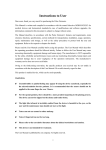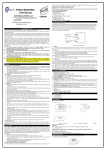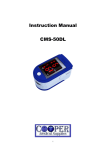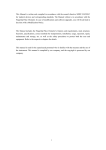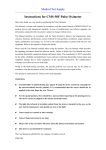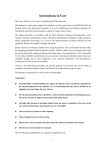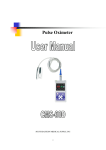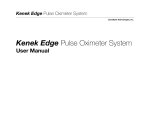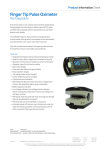Download Pulse Oximeter
Transcript
Pulse Oximeter I Instructions for Use Please read the User Manual carefully before using this product. The User Manual, which describes the operating procedures, should be followed strictly. The manufacturer is NOT responsible for the safety, reliability and performance issues and any monitoring abnormality, human injury and equipment damage due to users' negligence of the operation instructions. WARNING: It is recommended that the sensor should not be applied to the same finger for longer than 2 hours. Uncomfortable or painful feelings may appear if the device is used for extensive periods of time. The Infrared light on the device is harmful to the eyes. Do Not stare at the light. Wash hands before use. Device works more accurately when nails and fingers are clean of dirt, make-up, and nail polish. Please refer to the manual about the clinical restrictions and cautions. This device is not intended for treatment. II Contents 1 Safety.................................................................................................................................................1 1.1 Instructions for safe operations .......................................................................................................... 1 1.2 Warnings............................................................................................................................................. 1 1.3 Attentions ........................................................................................................................................... 1 2 Overview ...........................................................................................................................................2 2.1 Classification:..................................................................................................................................... 2 2.2 Features .............................................................................................................................................. 2 2.3 Major applications and scope of application ...................................................................................... 2 2.4 Environment requirements ................................................................................................................. 3 3 Principle and Caution......................................................................................................................3 3.1 Principle of measurement................................................................................................................... 3 3.2 Caution ............................................................................................................................................... 4 3.3 Clinical restrictions ............................................................................................................................ 4 4 Technical specifications ...................................................................................................................4 5 Accessories ........................................................................................................................................5 6 Installation........................................................................................................................................5 6.1 View of the front panel ....................................................................................................................... 5 6.2 Battery................................................................................................................................................ 5 6.3 Attaching the lanyard ......................................................................................................................... 6 7 Operating Guide ..............................................................................................................................7 8 Repairing and Maintenance............................................................................................................7 9 Troubleshooting................................................................................................................................8 10 Key of Symbols...............................................................................................................................8 11 Function Specification ...................................................................................................................9 III 1 Safety 1.1 Instructions for Safe Operation Check the main unit and all accessories periodically to make sure that there is no visible damage that may affect patient’s safety and monitoring performance. It is recommended that the device should be inspected at least once a week. When there is obvious damage, stop using the device. Qualified service engineers should perform necessary maintenance ONLY. The oximeter cannot be used together with devices not specified in User’s Manual. Only accessories that are included or are recommended by the manufacturer should be used with this device. This product is calibrated before leaving the factory. 1.2 Warnings Explosive hazard—DO NOT use the oximeter in environments with flammable gases such as ignitable anesthetic agents. DO NOT use the oximeter at the same time as MRI and CT testing. DO NOT use if allergic to Rubber. Follow local laws and regulations for the disposal of packaging and accessories (Including batteries, plastic bags, foam and boxes). Before throwing away the packaging, Please check to make sure the device and accessories are all included and the device works properly. 1.3 Attention Keep the oximeter away from dust, vibration, corrosive substances, explosive materials, high temperature and moisture. If the oximeter gets wet, please stop use. Do Not leave in extreme heat or cold. DO NOT use sharp instruments to press buttons on Oximeter. Do Not Use high temperature or high-pressure steam to clean and disinfect Oximeter Refer to User Manual in chapter 8 for instructions on cleaning and disinfecting. Do not completely emerge oximeter in water. When cleaning is needed, wipe the surface with a soft cloth dampened with medical alcohol. Do not spray any liquid directly on the device. It would most likely affect the normal measurement of the patients' SpO2 and pulse rate if fingers are too cold or too small. It is recommended to place the oximeter on your thumb or middle finger for most accurate readings. Do not use the device on infants or neonatal patients. The product is suitable for anyone 4 years of age and older. The device may not work for all patients. If you are unable to achieve stable readings, discontinue use. Data will update every 5 seconds. 1 If abnormal readings are displayed during use, pull out finger and try again. The lanyard attached to the product is made from non- allergy material, if sensitive to the Lanyard, stop using it. In addition, do not wear the lanyard around your neck. The oximeter does not have low-voltage alarm function; it only shows the low-voltage on the screen. Change the batteries when batteries are low. Batteries should be removed if the device is going to be stored for a month or longer. There is a flexible circuit that connects the two halves of the device. Do not twist or pull on the connection. 2 Overview The pulse oxygen saturation is the percentage of HbO2 in the total Hb in the blood, so-called the O2 concentration in the blood. It is an important bio-parameter for respiration. The Pulse Oximeter was developed for the purpose of measuring the SpO2 more easily and accurately. At the same time, the device can measure pulse rate. The Pulse Oximeter features in small volume, low power consumption, convenient operation and portability. It is only necessary for patients to put one finger into the fingertip photoelectric sensor for diagnosis, and a display screen will show measured value of Hemoglobin Saturation. 2.1 Classification: Class II b, (MDD93/42/EEC IX Rule 10 ) 2.2 Features Operation of the product is simple and convenient. The product is small in volume, light in weight (total weight is approximately 2 ounces including batteries) and convenient for carrying. Power consumption of the product is low and the two AAA batteries can be operated continuously for 24 hours. The product will automatically power off within 5 seconds when there is no signal to the product 2.3 Major applications and scope of application The Pulse Oximeter can be used to measure human Hemoglobin Saturation and pulse rate and indicate the pulse intensity by the bar-display. The product is not suitable for continuous use on patients. Overrating will occur when the patient is suffering from toxicosis, which may be caused by carbon monoxide. The device is not recommended to be used under these circumstances. 2 2.4 Environment requirements Storage Environment a) Temperature : -40° ) Relative humidity: ) Atmospheric pressure : b c F to 140°F (-40℃ to +60℃) 5%~95% 500hPa~1060hPa Operating Environment a) Temperature: : 50° b) Relative Humidity : ) Atmospheric pressure: c F to 104°F (10℃ to 40℃) 30%~75% 700hPa~1060hPa 3 Principle and Caution 3.1 Principle of Measurement Principle of the Oximeter is as follows: An experience formula of data process is established by making use of Lambert Beer Law according to Spectrum Absorption Characteristics of Reductive Hemoglobin (Hb) and Oxyhemoglobin (HbO2) in glow & near-infrared zones. Operation principle of the instrument is: Photoelectric Oxyhemoglobin Inspection Technology is adopted in accordance with Capacity Pulse Scanning & Recording Technology, so that two beams of different wavelengths of light can be focused onto the human nail tip through a perspective clamp finger-type sensor. Then a measured signal can be obtained using a photosensitive element, information acquired through which will be shown on a screen via the electronic circuits and microprocessor. Figure 1. Operating Principle 3 3.2 Caution 1. 2. 3. 4. 5. 6. 7. The finger should be placed properly (see the attached illustration in, Figure 5 on pg. 7), or it may cause inaccurate measurements. The SpO2 sensor and photoelectric receiving tube should be arranged in a way where the subject’s arteriole is positioned in between The SpO2 sensor should not be used when subject is receiving intravenous injections, or wearing a blood pressure cuff. Make sure the optical path is free from any objects. Excessive ambient light may affect the measuring results. This includes but is not limited to fluorescent lamps, infrared heat lamps, and direct sunlight. Strenuous activity or extreme electrosurgical interference may also affect the accuracy. Makeup or nail polish will affect the accuracy. Remove any makeup or nail polish before use. Make sure fingernails are not too long. . 3.3 Clinical restrictions 1. 2. 3. 4. Because the measurement is taken on the basis of arteriole pulse, substantial pulsating blood flow of subject is required. For a subject with weak pulse due to shock, low ambient/body temperature, major bleeding, or use of vascular contracting drug, the SpO2 waveform (PLETH) will decrease. In this case, the measurement will be more sensitive to interference. For those with a substantial amount of staining dilution drug (such as methylene blue, indigo green and acid indigo blue), carbon monoxide hemoglobin (COHb), methionine (Me+Hb), thiosalicylic hemoglobin, and some with icterus problem, the SpO2 determination by this monitor may be inaccurate. Drugs such as dopamine, procaine, prilocaine, lidocaine and butacaine may also be a major factor for serious errors of SpO2 measurement. Becasue the SpO2 value serves as a reference of anemic anoxia and toxic anoxia, some patients with serious anemia may also report good SpO2 measurement. 4 Technical specifications 4.1 Display Format: LED Display; SpO2 Measuring Range: 0% - 100%; Pulse Rate Measuring Range: 30 bpm - 250 bpm; Pulse Intensity Display: Columniation display 4.2 Power Requirements: 2 1.5V AAA alkaline batteries Rechargeable batteries can also be used , adaptable range: 2.6V~3.6V. 4.3 Power Consumption: Smaller than 25 mA. 4.4 Resolution: 1% for SpO2 and 1 bpm for Pulse Rate. 4.5 Measurement Accuracy: 2% in stage of 70%-100% SpO2, and meaningless when stage being × ( ± 4 ) ± ± smaller than 70%. 2 bpm or 2% (select larger) for Pulse Rate. 4.6 Measurement Performance in Weak Filling Condition: SpO2 and pulse rate can be shown correctly when pulse-filling ratio is 0.4%. SpO2 error is 4%, pulse rate error is 2 bpm or 2% (select larger). 4.7 Resistance to surrounding light: The deviation between the value measured in the condition of man-made light or indoor natural light and that of darkroom is less than ±1%. 4.8 It is equipped with a function switch so that the Oximeter will be powered off when no finger is the Oximeter for 5 seconds. 4.9 Optical Sensor Red light (wavelength is 660nm,6.65mW) Infrared (wavelength is 880nm, 6.75mW) ± 5 Accessories Lanyard Two x AA Batteries (NOT Included) User Manual 6 ± ± Installation 6.1 View of the front panel Figure 2. Front View 6.2 Battery Step 1. Refer to Figure 3. Slid off cover an insert two AAA size batteries properly in the right direction. Step 2. Replace the cover. 5 Please take care when you insert the batteries for improper insertion may damage the device. Figure 3.Battery Installation 6.3 Attaching the Lanyard Step 1. Insert the end of the lanyard through the hole. Step 2. Slide the other end of the lanyard through the loop and then tighten. Figure 4. Attaching the Lanyard 6 7 Operating Guide 7.1 Open the clip and place finger in as shown in Figure 5. Figure 5. Put finger in position 7.2 Finger should be inbetween the rubber cushions of the clip (make sure the finger is in the right position), and then close the clip over the finger. 7.3 Press the power button once on front panel. 7.4 Do not shake the finger and keep the patient at ease during the process. Body movement is not recommended while waiting for the reading. 7.5 Information and measurement will be displayed on the screen. Fingernails and the LED Display should be on the same side. 8 Repairing and Maintenance Change the batteries when the low-voltage display is on the screen. Clean the surface of the device before using. Wipe the device with medical alcohol and then let it air dry or dry it off with a clean cloth. Using the medical alcohol to disinfect the product after use will help to prevent cross contamination. Remove Batteries if the oximeter is not going to be used for a long period of time. The best storage environment for the device is -40° ° - 40ºC to 60ºC) ambient temperature and relative humidity is not higher than 95%. F to 140 F ( Do Not use High-pressure sterilization on the device. Do not immerse the device in water. 7 It is recommended that the device be kept in a dry environment. Humidity may reduce the useful life of the device, or even damage it. 9 Troubleshooting Trouble The SpO2 and Pulse Rate can not be displayed normally Possible Reason Solution 1. The finger is not positioned properly. 1. Readjust the finger and try again. 2. The patient’s SpO2 is too low to be 2. Try again; Go to a hospital for a detected. diagnosis if you are sure the device is working properly. 1. The finger is not placed inside deep 1. Readjust the finger and try again. enough. The SpO2 and Pulse Rate are not displayed 2. The finger is shaking or the patient is 2. Keep the patient calm. stably moving. 1. The batteries are drained or almost drained. The device can not be 2. The batteries are not inserted turned on properly. 3. The device is malfunctioning. The display is off suddenly 1. The device will power off automatically when it gets no signal within 5 seconds. 2. The batteries are almost drained. 1. Change batteries. 2. Reinstall batteries. 3. Please contact your local service center. 1. Normal. 2. Change batteries. 10 Key of Symbols Symbol Description Type BF Warning – See User Manual SpO2% The pulse oxygen saturation (%) Pulse rate (bpm) Low Battery (Change the battery to avoid an inaccurate reading 1. No finger inserted 2. An indicator of signal inadequacy Battery positive electrode Battery cathode 8 ) Power switch Alarm inhibit WEEE (2002/96/EC) IPX1 Ingress of liquids rank 11 Function Specification Display Information The Pulse Oxygen Saturation ( ) (SpO ) 2 Display Mode LED Pulse Rate BPM LED Pulse Intensity (bar-graph) LED bar-graph display SpO2 Parameter Specification Measuring range Accuracy Optical Sensor ~ 70%~100%:±2% ,Below 70% unspecified. 0% 100%, (the resolution is 1%). Red light (wavelength is 660nm) Infrared (wavelength is 880nm) Pulse Parameter Specification ~ Measuring range 30bpm 250bpm (the resolution is 1 bpm) Accuracy ±2bpm or 2% select larger ± Pulse Intensity Range Continuous bar-graph display, the higher display indicates a stronger pulse. Battery Requirement 2 x 1.5V (AAA size) Alkaline batteries Battery Useful Life Two batteries can work continually for 24 hours Dimensions and Weight Dimensions 2.25”(L) × 1.25”(W) × 1.25”(H) Weight About 2 ounces (with the batteries) 9













